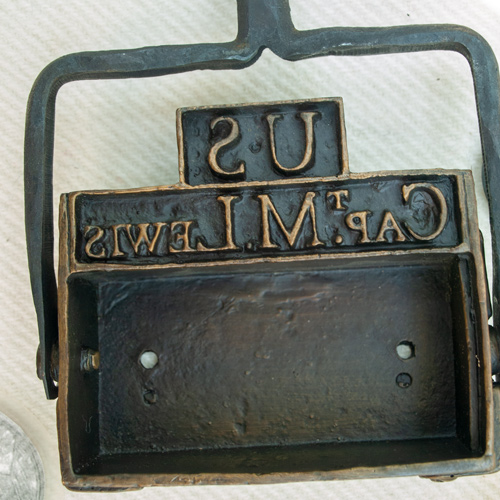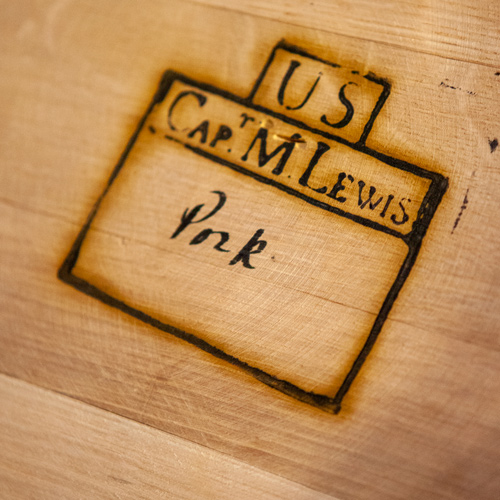Lewis’s Label Maker
Lewis’s Branding Iron (replica)
© 2010 by Kristopher K. Townsend. Permission to use granted under the Creative Commons Attribution-Share Alike 4.0 International license.
Lewis may have had this branding iron custom-made before he left the East, perhaps at Harpers Ferry, although there is no mention of it in existing records. Such tools commonly were used for marking wooden packing crates and barrels, and on leather bags, until the early 20th century. The frame below Lewis’s name would outline a space in which details such as numbers or letters could be burned or painted into the wood or leather, in order to organize parcels by contents or weight and, in this instance, to identify it as U.S. Government property. It was a distant forerunner of the rubber stamp, a sort of pre-digital barcode.
Lewis’s brand is frequently inferred from information in the journals that it was also used to blaze the expedition’s trail, so as to notify later travelers that others had preceded them, but that is an overstatement based on a questionable premise. Private Joseph Whitehouse once wrote that the captains “had several Trees branded, with their Names” on 4 June 1804, near the mouth of the Moreau River, about 140 miles up the Missouri. Perhaps they did that as a visible reminder for later reference by themselves or their agents, to identify that area as being rich in lead ore (or so they had been told). And when the men hid the red pirogue on an island at the mouth of the Marias River on 10 June 1805, Lewis recorded: “Put my brand on several trees standing near her,” and Sergeant Ordway added, “to prevent the Savages from disturbing her.” He may have used his branding instrument for that purpose, perhaps having been told by someone at Fort Mandan that natives regarded the white man’s handwriting as having supernatural powers.
On 20 April 1806, while camped above the Long Narrows of The Dalles, near today’s Columbia Hills State Park, Lewis mentioned that he had traded some elk skins, “old irons,” and two canoes for beads, thus reducing his inventory and gaining a little capital. This may explain why his “signature” iron was found in the Columbia River in the vicinity of The Dalles, Oregon, in the early 1890s.[1]Gary E. Moulton, ed., The Journals of the Lewis & Clark Expedition (13 vols., Lincoln: University of Nebraska Press, 1983–2001), 4:277n. Lewis’s branding iron is now in the possession of … Continue reading
Trail Memorials
Branded Keg
Taken in cooperation with the Fort Mandan Visitors Center. Photo © 2013 Kristopher K. Townsend. Permission to use granted under the Creative Commons Attribution-Share Alike 4.0 International license.
In January 1796, James Mackay of the Commercial Company for the Discovery of the Nations of the Upper Missouri, a Spanish enterprise commonly called the Missouri Company, dispatched the young explorer and trader, John Evans, up the Missouri River “to discover a passage from the sources of the Missouri to the Pacific Ocean.” Among other things, he instructed Evans to:
. . . mark your route in all places where there will be a portage to pass from one river to another or from one water-fall to another by cutting or notching some trees or by some piles of stones engraved and cut; and take care to place in large letters Charles IV King of Spain and below Company of Missouri, the day, the month, and the year when you do this in order to serve as unquestionable proof of the journey that you are going to make.
The procedure was inherently powerful. Mackay warned Evans that if he were to come upon the Russian settlement that was rumored to exist somewhere north of California, “you will cease to make any sign of taking possession, for fear of having spring up with these foreigners any jealousy which would be prejudicial to the success of your journey.”[2]A. P. Nasatir, Before Lewis and Clark (2 vols., Lincoln: Bison Book, 1990), 413.
Three years earlier, Alexander Mackenzie, in search of a navigable water route across North America, had left his mark, his tag, at the end of his long trek from Montreal to the Pacific Ocean:
I now mixed up some vermilion in melted grease, and inscribed, in large characters, on the South East face of the rock on which we had slept last night, this brief memorial—”Alexander Mackenzie, from Canada, by land, the twenty-second of July, one thousand seven hundred and ninety-three.”[3]Walter Sheppe, ed., Journal of the Voyage to the Pacific: Alexander Mackenzie (Mineola, NY: Dover, 1995), 239.
Similarly, at their camp on Chinook Point (“Point Distress”) on 23 November 1805, William Clark marked his name, “the Day of the month & year on a Beech trees & (By Land). Capt. Lewis Branded his and the men all marked their nams on trees about the Camp.” A modern graffiti writer might call that a “throwup.”
At times the men of the Corps added “U.S.” to their tags, as well as the latitude of the place if Lewis had taken the necessary observations.
They marked their passage almost from the start. On 23 May 1804, two days after leaving St. Charles, Missouri, they stopped to inspect Tavern Cave where, Clark said, “many names are wrote up on the rock. Mine among others.” (see also Trail Graffiti)
Origin
Roy Appleman supposed it was made by Private John Shields, whose ingenuity was highly respected by the captains.[4]Roy E. Appleman, Lewis & Clark: Historic Places Associated with Their Transcontinental Exploration (1804-06 ) (Washington, D.C.: National Park Service, 1975), 373 note 120. “Without having served any regular apprenticeship to any trade,” Lewis wrote on 10 June 1805, “he makes his own tools principally, and works extreemly well in either wood or metal, and in this way has been extreemely servicable to us.” However a moment’s study of the instrument in question leads one to wonder whether even the very best “fix-it” man could have made the casting of the owner’s name under the best of working conditions, much less in the field.
Furthermore, serious students of horse lore and tack maintain that Lewis’s branding iron would not have been used to brand horses. It was unnecessarily large and detailed, and the empty rectangular outline would have served no purpose.[5]Robert R. Hunt, “Hoofbeats & Nightmares: A Horse Chronicle of the Lewis and Clark Expedition,” We Proceeded On, Vol. 21, No. 1 (February 1995), 4–9. Upon leaving their remuda with the Nez Perce Indians en route west in October 1805, Whitehouse wrote: “Got up our horses and cropped their fore mane, and branded them with a Sturrup Iron on the near [left] fore Shoulder, So that we may know them again at our return.” A “stirrup iron” is the D-shaped metal loop in which the rider’s foot rests. When heated, the bottom of it could be used to burn a plain line into a horse’s hide; one or more additional lines could be added to make a distinctive design, such as a “T” or an “L.” Prior to the 1830s there was no official brand for Army horses.
The author thanks Hank Mathiason, Clancy, Montana; historian Robert Moore of the National Park Service; and artist Michael Haynes, for their advice.
Notes
| ↑1 | Gary E. Moulton, ed., The Journals of the Lewis & Clark Expedition (13 vols., Lincoln: University of Nebraska Press, 1983–2001), 4:277n. Lewis’s branding iron is now in the possession of the Oregon Historical Society. |
|---|---|
| ↑2 | A. P. Nasatir, Before Lewis and Clark (2 vols., Lincoln: Bison Book, 1990), 413. |
| ↑3 | Walter Sheppe, ed., Journal of the Voyage to the Pacific: Alexander Mackenzie (Mineola, NY: Dover, 1995), 239. |
| ↑4 | Roy E. Appleman, Lewis & Clark: Historic Places Associated with Their Transcontinental Exploration (1804-06 ) (Washington, D.C.: National Park Service, 1975), 373 note 120. |
| ↑5 | Robert R. Hunt, “Hoofbeats & Nightmares: A Horse Chronicle of the Lewis and Clark Expedition,” We Proceeded On, Vol. 21, No. 1 (February 1995), 4–9. |


